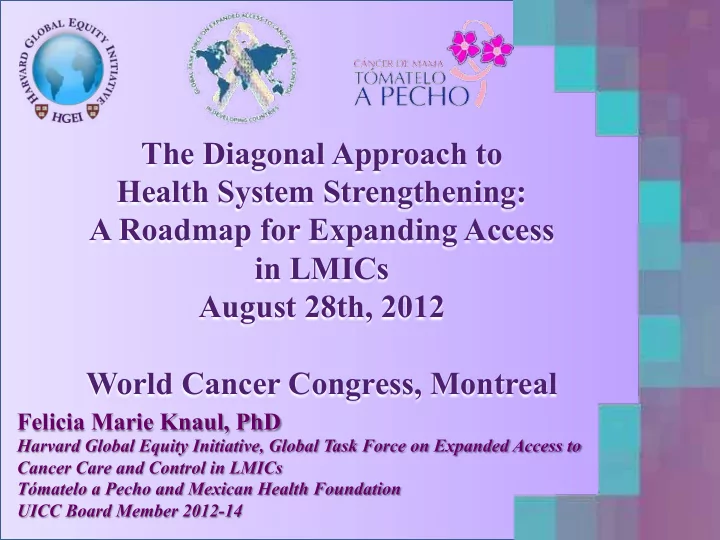

The Diagonal Approach to Health System Strengthening: A Roadmap for Expanding Access in LMICs August 28th, 2012 World Cancer Congress, Montreal Felicia Marie Knaul, PhD Harvard Global Equity Initiative, Global Task Force on Expanded Access to Cancer Care and Control in LMICs Tómatelo a Pecho and Mexican Health Foundation UICC Board Member 2012-14
From anecdote … … to evidence
January,(2008( June,(2007(
Juanita: Advanced metastatic breast cancer is the result of a series of missed opportunities to harness health systems using the diagonal approach
GTF.CCC Members !
Global Task Force on Expanded Access to Cancer Care and Control in Developing Countries = global health + cancer care
Closing the Cancer Divide: A BLUEPRINT TO EXPAND ACCESS IN LMICs Applies a diagonal approach to avoid the false dilemmas between disease silos -CD/NCD- that continue to plague global health
Challenge and disprove the myths about cancer/NCD/ Chronic illness Expanding access to cancer care and control in low and middle income countries: M1. Unnecessary • Should, M2. Unaffordable M3. Impossible • Could, and M4: Inappropriate • Can….. be done
Women and mothers in LMICs face many risks through the life cycle Women 15-59, annual deaths Mortality Cervical Breast Diabetes in - 35% cancer cancer childbirth in 30 years 166,577 142,744 342,900 120,889 = 430, 210 deaths Source: Estimates based on data from WHO: Global Health Observatory, 2008 and Murray et al Lancet 2011.
The Cancer Divide: An Equity Imperative Cancer is a disease of both rich and poor; yet it is increasingly the poor who suffer: 1. Exposure to risk factors 2. Preventable cancers (infection) Facets 3. Treatable cancers: death and disability 4. Stigma and discrimination 5. Avoidable pain and suffering
The Opportunity to Survive (M/I) Should Not Be Defined by Income 100% Adults Children inequality gap Survival Leukaemia All cancers LOW HIGH LOW HIGH INCOME INCOME INCOME INCOME In Canada, almost 90% of children with leukemia survive. In the poorest countries only 10%. Source: Knaul, Arreola, Mendez. estimates based on IARC, Globocan, 2010.
Cancer – especially in women and children - adds a Stigma: layer of discrimination onto ethnicity, poverty, and gender. Survivorship care is non- existent.
The most insidious injustice: lack of access to pain control ! Non-methadone, Morphine Equivalent opioid consumption per death from HIV or cancer in pain: Poorest 10%: 54 mg per death Richest 10%: 97,400 mg per death
The Diagonal Approach to Health System Strengthening " Rather than focusing on disease-specific vertical programs or only on horizontal system constraints, harness synergies that provide opportunities to tackle disease-specific priorities while addressing systemic gaps. " Optimize available resources so that the whole is more than the sum of the parts. " Bridge the divide as patients suffer diseases over a lifetime, most of it chronic.
The diagonal approach: delivery and financing Diseases(and(Interven=ons:(Benefits( Ver=cal(Coverage(of(( Horizontal(Coverage:(Beneficiaries(
Diagonal Strategies: Positive Externalities " Promoting prevention and healthy lifestyles: " Reduces risk for cancer and many other diseases " Reducing stigma around women’s cancers: " Reduces gender discrimination " Introducing cancer treatment for children " Improves hygiene and reduces intra-hospital infections " Promoting access to education for children w/ cancer " Reduces poverty, contributes to social development " Pain control and palliation " Reducing barriers to access is essential for cancer as well as for for other diseases and for surgery.
‘Diagonalizing’ Delivery: Delivery : Harness platforms by integrating breast and cervical cancer prevention, screening and survivorship care into MCH, SRH, HIV/AIDS, social welfare and anti-poverty programs. Example: • Mexico: integration of breast and cervical cancer awareness and screening into the national anti-poverty program Oportunidades
‘Diagonalizing’ Financing: Integrate cancer care and control into national insurance and social security programs to express previously suppressed demand beginning with cancers of women and children: " Mexico, Colombia, Dom Rep, Peru " China, India, Thailand " Rwanda, Ghana, South Africa
Investing in CCC: We Cannot Afford Not To " Health is an investment, not a cost " Economic cost of cancer, 2010: 2-4% of global GDP 1/3-1/2 of cancer deaths are “avoidable”: 2.4-3.7 million deaths, 80% in LIMCs " Prevention and treatment offer potential, untapped world savings of $US 100-200 billion " The costs of prevention and treatment are often less that many fear especially using a diagonal approach
Expanding CCC Necessary…… • Affordable • Possible • Appropriate
Be an optimalist optimist Expanding access to cancer care and control in LMICs: Should, Could, and Can be done
Recommend
More recommend